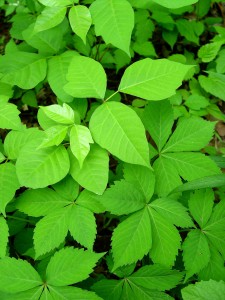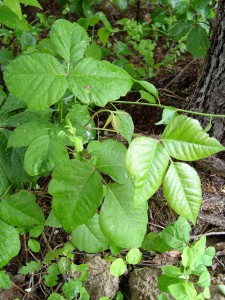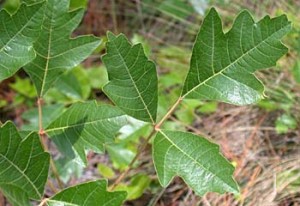Poison Ivy: The Plant that Bites Back
September 8th, 2015
Plants are generally pretty docile and defenseless creations.
If your dog wants to dig up a daylily or you feel like decapitating a cabbage for dinner, there’s really not much the plants can do about it.
Then there’s Toxicodendron radicans, better known as poison ivy.
Now THAT’S a plant that can bite back!
Poison ivy’s key weapon is a potent oil called “urushiol,’ which causes an annoying to dreadfully painful skin rash in an estimated 85 percent of people who come into contact with it.
The plant itself is a tough, adaptable vine that lurks most everywhere, from shady wooded areas to roadside banks to that forgotten corner of the backyard.
Some evidence suggests it’s been getting worse lately due to the warming climate, so you might not be imagining it if it seems that way in your yard.
The dreaded itching usually begins within 24 to 36 hours of getting the oil on your skin. Exposed areas turn red and may blister, then typically crust over and heal within two weeks.
That’s bad enough. But for about one in 10 people, the rashes are severe, painful and in extreme cases, even life-threatening.
Randy Connolly found that out when he was 7 years old.
Connolly was playing baseball one day in a park in his native Massachusetts when a neighbor decided to burn some brush and leaves. In the pile was poison ivy.
Urushiol oil in the smoke caused a severe allergic reaction in Connolly’s lung lining. He spent two weeks in the hospital and nearly died.
Ever since, he’s had immediate and severe reactions to any contact with urushiol. Needless to say, Connolly and his wife, Heidi Ratner-Connolly, who also reacts to urushiol, are more vigilant about poison ivy than your average people.
Ratner-Connolly says the secret is 1.) knowing what this “ghoulish greenery” looks like, 2.) taking a few basic precautions to avoid it, and 3.) knowing what to do in case you come into contact with it.
Sounds simple. But when the Connollys were first developing their anti-poison-ivy game plan, they found a lot of myths, half-truths and anecdotal advice.
“Since Randy almost died from inhaling the smoke, we were always worried about contact with it,” says Ratner-Connolly. “But we just couldn’t find one resource with all the information we needed.”
So they researched and wrote their own. Their book is “10 Things to Know About Poison Ivy, Pets and People” by Heidi Ratner-Connolly and Randy Connolly (2Lakes Publishing, 2004, $9.95 paperback).
Native Americans warned the early European settlers about this wretched vine as early as 1609, when Capt. John Smith coined the term “poison ivy” and logged it in his records.
That it’s still around today – healthier than ever – is a testament to its tenacity.
Ben Franklin’s saying, “Leaves of three, let them be,” is still great advice, says Ratner-Connolly.
“Identification and avoidance are the ONLY real means of prevention,” she says.
Poison ivy leaves grow in clusters of three with the middle leaf being slightly bigger than the two on either side.

Here’s poison ivy (left) mixing with Virginia creeper (right). Notice that poison ivy has three leaves per cluster while Virginia creeper has five leaves per cluster.
The leaves start out reddish in spring, then become a shiny green in summer before turning various attractive shades of red, orange and yellow in fall. Small, waxy white berries also form in late summer and turn red in fall.
The vines suck onto trees or other nearby climbing surfaces, but if there’s nothing to grab onto, they’ll grow into a floppy shrub. As the vines age, the stems become woody and put out distinctive “hairy” root growths.
Much of the time, people develop rashes without ever realizing they came into contact with poison ivy.
It doesn’t take much. Urushiol is so potent that even a quarter of an ounce of the stuff is enough to give a rash to every person on the planet.
“It’s a really powerful irritant,” Ratner-Connolly says. “Not only does a little bit do a lot of damage, but it’s an invisible oil. It’s hard to avoid something you can’t see.”
The oil is in every part of the plant, not just the leaves, and it can remain viable for as long as five years after the plant has died. So don’t assume you’re safe yanking dead vines off a tree or pulling them when leafless over winter.
Direct contact with a vine isn’t the only way you can get a rash, says Ratner-Connolly.
She says the oil is easily transferred from plants to objects to people – including tools, clothing, shoe bottoms, even stray baseballs and soccer balls retrieved from a weedy area.
Obviously, one of the best ways to lessen the threat is by eliminating nearby poison ivy plants. That’s not easy, but it’s possible.
“Diligence is the key,” says Ratner-Connolly. “You have to get every bit of the plants, leaves, vines and roots, or they will simply sprout again.”
The earlier the better.
“Repeated cutting to the ground will eventually starve out the plant’s root system,” Ratner-Connolly says. “Of course, the hardest part is trying to avoid poisoning while you’re trying to remove it. Always wear protective clothing and try to cover as much of your skin as possible.”
If you’re a spray-oriented person, the Connollys suggest glyphosate-containing weed-killers such as Round-Up, Kleen-Up and Brush-B-Gon to kill the foliage. They also like ordinary white vinegar.
Just be careful using any of those around “good” plants because they’ll kill most anything green. Placing a stone-topped plastic barrier over the cleared surface will help prevent new poison-ivy seed from germinating.
Whatever you do, Ratner-Connolly says, don’t mow, weed-whack or burn poison-ivy plants – dead or alive. That will only spew the oil around more.
Protective creams such as Ivy Block, Tecnu, Multi-Shield and the new “buji Block” help some people, the Connollys say, and so does simply covering up all exposed skin with gloves and clothing.
Tips on prevention:
If you come into contact with poison ivy and its oil, author Heidi Ratner-Connolly advises washing it off ASAP with lots of plain, cold water.
You’ll probably head off a rash if you can wash within 15 minutes. After then, the oil binds irreversibly to skin proteins.
Also wash clothing and other objects so you don’t pick up an indirect, secondary allergic reaction later, she adds.
Randy Connolly also likes to wash with soap (the laundry soap Fels Naptha is his favorite) after washing first with cold water. Another new post-exposure product is “buji Wash,” an exfoliating cleanser that helps remove urushiol.
If a reaction occurs, the Connollys recommend any of a variety of creams and treatments that lessen the itch, including calamine lotion, Epsom salts, bicarbonate of soda, Aveeno oatmeal bath, aloe gel and/or goldenseal root powder.
Over-the-counter cortisone cream or Zanfel Poison Ivy cream also may help mitigate a reaction.
For severe reactions, the Connollys advise seeing a doctor for a possible round of oral steroids. Antibiotics also may be needed in cases where the rash has become infected.
Some other interesting factoids about poison ivy:
* People aged 5 to 20 tend to be most sensitive to poison ivy. Sensitivity tends to lessen from the 30s on, although it’s also possible for previously non-sensitive people to suddenly develop an allergic reaction at any age.
* Reactions usually vary depending on how much urushiol oil you’ve contacted. Higher doses and prolonged contact typically produce worse symptoms.
* Eating poison ivy doesn’t build up a resistance to it. There is, however, a vaccine that can help reduce skin reactions to urushiol.
* Poison ivy is not contagious. You won’t get it from touching someone’s rash or blisters. However, you can react if unwashed urushiol oil on someone else’s skin or clothing rubs onto your skin.
* Most animals do not react to poison ivy. Many birds eat poison-ivy berries, and deer and small mammals even eat poison-ivy leaves with no ill effects.
* Although dogs and cats don’t get skin rashes, they can have life-threatening reactions after eating poison ivy or its berries. Call a vet or one of the two National Animal Poison Control Centers at 1-800-548-2423 or 1-888-426-4435 if your pet has eaten poison ivy. (Note: The poison control centers charge fees for consultations.)
— Source: “10 Things to Know About Poison Ivy, Pets and People”
Other skin-rash plants:
Poison ivy is one of three woody perennial weeds that commonly cause skin rashes.
Also a threat is poison oak and poison sumac, which contain the same urushiol oil as poison ivy.
Like poison ivy, poison oak grows in clusters of three leaves that start out reddish in spring, turn glossy green in summer and then take on fall colors of red, orange and yellow.
The leaf tips of poison oak are more rounded than poison ivy’s pointed tips, and poison oak is more commonly found growing as a bushy shrub or groundcover than climbing as a woody vine. Poison oak also puts out waxy, white berry clusters that turn red in fall.
Poison sumac has pointy leaves like poison ivy and the same changing leaf colors. However, its leaves grow in pairs opposite one another on the stems. It also gets white berries that turn red in fall.
The native but non-poisonous staghorn sumac looks very much like poison sumac except it has small hairy projections on the stems. Poison sumac has smooth, hairless stems.









